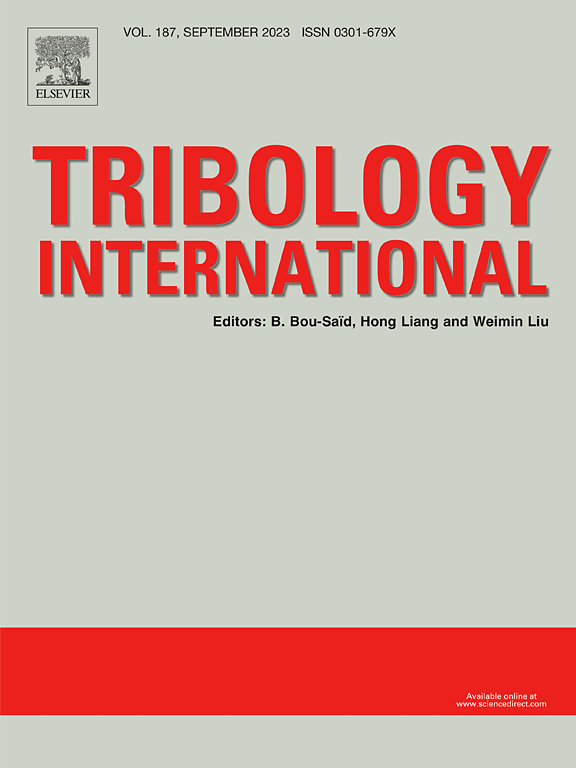流动腐蚀表征的热力学框架
IF 6.1
1区 工程技术
Q1 ENGINEERING, MECHANICAL
引用次数: 0
摘要
腐蚀引起的材料降解是各个行业面临的重大挑战。腐蚀与其他降解机制(如磨损、流体运动和侵蚀)的协同作用往往会大大增加其有害影响。虽然已经研究了低碳钢磨损和腐蚀之间的协同作用,但这项工作的重点是较少探索的相互作用:由非接触滑动引起的电解质运动对腐蚀降解的影响。实验结果表明,在没有接触的情况下,由滑动副的往复运动引起的电解质运动会影响腐蚀引起的材料降解,这是现有模型之前没有考虑到的影响。此外,提出了一种在腐蚀研究中应用所需电压之前进行开路电位(OCP)测量的适当方法。使用3D轮廓和微观分析的表面分析证实了电解质静态和动态条件下材料去除和形貌的变化。为了模拟这种协同效应,我们采用了根据不可逆热力学定律开发的退化熵生成(DEG)定理。DEG框架引入了降解系数B,建立了腐蚀造成的材料损失与熵生成之间的关系。不同过电位和引脚速度的实验(诱导不同的电解质运动)表明,无论实验条件如何,材料降解和熵产生之间都存在一致的线性关系。通过扫描电子显微镜(SEM)获得的放大表面图像和通过能量色散x射线能谱(EDS)分析获得的元素组成数据支持了这些发现暴露于各种腐蚀条件下的样品。这一结果强调了降解系数B与腐蚀条件和电解质运动无关,这对于模拟不同操作条件下的腐蚀行为是有价值的,对未来的摩擦磨损建模至关重要。本文章由计算机程序翻译,如有差异,请以英文原文为准。
Thermodynamic framework for characterization of flow-induced corrosion
Corrosion-induced material degradation is a significant challenge across various industry sectors. The synergistic interaction of corrosion with other degradation mechanisms like wear, fluid motion, and erosion tends to increase its detrimental effects substantially. While the synergy between wear and corrosion in low-carbon steels has been studied, this work focuses on a less-explored interaction: the influence of electrolyte motion induced by non-contact sliding on corrosion degradation. Experimental findings demonstrate that corrosion-induced material degradation is influenced by electrolyte motion induced by the reciprocating movement of sliding pairs in the absence of contact, an effect not previously considered in existing models. Furthermore, an appropriate approach for conducting open circuit potential (OCP) measurements prior to applying the desired voltage in corrosion studies is proposed. Surface analyses using 3D profiling and microscopic analysis confirm variations in material removal and topography between static and dynamic conditions of the electrolyte. To model this synergistic effect, we employ the Degradation Entropy Generation (DEG) theorem developed in accordance with the laws of irreversible thermodynamics. The DEG framework introduces the degradation coefficient B, establishing a relationship between material loss due to corrosion and entropy generation. Experiments with varying overpotential and pin speeds (inducing different electrolyte motions) revealed a consistent linear relationship between material degradation and entropy generation, irrespective of experimental conditions. The findings are supported by the magnified surface images obtained through Scanning Electron Microscopy (SEM) and the elemental composition data acquired from Energy Dispersive X-ray Spectroscopy (EDS) analysis of samples exposed to various corrosion conditions. This outcome highlights that the degradation coefficient B is independent of corrosive conditions and electrolyte motion, which is valuable for modeling corrosion behavior under varying operating conditions and essential for future tribo-wear modeling.
求助全文
通过发布文献求助,成功后即可免费获取论文全文。
去求助
来源期刊

Tribology International
工程技术-工程:机械
CiteScore
10.10
自引率
16.10%
发文量
627
审稿时长
35 days
期刊介绍:
Tribology is the science of rubbing surfaces and contributes to every facet of our everyday life, from live cell friction to engine lubrication and seismology. As such tribology is truly multidisciplinary and this extraordinary breadth of scientific interest is reflected in the scope of Tribology International.
Tribology International seeks to publish original research papers of the highest scientific quality to provide an archival resource for scientists from all backgrounds. Written contributions are invited reporting experimental and modelling studies both in established areas of tribology and emerging fields. Scientific topics include the physics or chemistry of tribo-surfaces, bio-tribology, surface engineering and materials, contact mechanics, nano-tribology, lubricants and hydrodynamic lubrication.
 求助内容:
求助内容: 应助结果提醒方式:
应助结果提醒方式:


